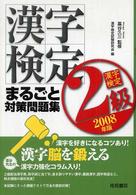- ホーム
- > 洋書
- > 英文書
- > Business / Economics
Full Description
When imagination becomes habit, it can transform your work and your life
The best corporations know that innovative thinking is the only competitive advantage that cannot be outsourced. The best schools are those that create cultures of imagination. Now in paperback, Imagination First introduces a wide-variety of individuals who make a habit of imaginative thinking and creative action, offering a set of universal practices that anyone can use to transform their life at work, home, and play. These 28.5 practices will enable anyone to become more imaginative and to teach others to do so as well from corporate executive to educator to platoon sergeant. Bonus content includes
Winning "practices" submitted by the public
Guidelines for educators who want to cultivate creativity in their classrooms
Expanded resource section
The book is filled with illustrative stories of creative leaders, teachers, artists, and scientists that clearly illustrate the original practices and new material that shows how to bring imagination to life.
Contents
Acknowledgments xi Lincoln Center Institute xv
The Authors xix
Part One • The Premise 1
Introduction 2
What, Why, and How 18
Part Two • The Practices 41
Practice 1 • Make Mist 42
Ready, get still, go
Practice 2 • Leave the Campfire 46
Know your enemy: it is you, scared
Practice 3 • Flip What's Foolish 52
Practice 4 • Make Way for Awe 58
Nurture humility and the wonder that comes with it
Practice 5 • Reinvent the Wheel 64
Be willing to give back the givens
Practice 6 • Think Inside the Box 68
Make greedy, grateful use of limits
Practice 7 • Hoard Bits 74
Collect obsessively; sift; trust that the right bits will emerge
Practice 8 • Mix Your Metaphors 80
Change the metaphors that frame your reality
Practice 9 • Renew Your Narrative 84
Ask whether your story still serves you
Practice 10 • Untie Your Tongue 90
Talk about your work with someone who doesn't understand it
Practice 11 • Swap Bodies 94
Lose yourself in a role
Practice 12 • Make a Gap 100
Obscure part of the picture
Practice 12.5 • Finish the Story 106
Make the ending open-ended
Practice 13 • Chunk It 108
Show how small it all starts
Practice 14 • Don't Blink 114
Snap in slow motion; see how you get primed for decision
Practice 15 • Cloud Appreciation 118
Search out ambiguity and sit with it
Practice 16 • Spotlight Off, Lantern On 124
Trade sharp focus for full-field awareness
Practice 17 • Play Telephone 128
Engage in meaning-laundering
Practice 18 • Help Out a Boobonian 132
Make every task a quest
Practice 19 • Teach Nonzero Math 138
Expand the pie before dividing it
Practice 20 • Microexperiment 142
Test your hunches playfully
Practice 21 • Rewrite History 146
Turn "what would've been" into "what could be"
Practice 22 • Design for the Hallway 152
Let informal spaces thrive
Practice 23 • Routinize Randomness 158
Regularly rinse out expectations
Practice 24 • Ride the z-axis 164
Find elemental forms, then play with scale
Practice 25 • Challenge Your Challenges 170
Find better problems
Practice 26 • Break the Hand 176
Unschool yourself periodically
Practice 27 • Yes and ... 180
Never say no to an idea
Practice 28 • Fail Well 186
Treat failure like a skill
Practice X • Make Up Your Own 192
Part Three • The Purposes 197
Conclusion 199
For Further Exploration 213
Index 237








